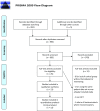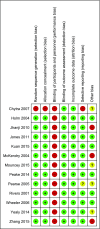Impact of hemodynamic goal-directed resuscitation on mortality in adult critically ill patients: a systematic review and meta-analysis
- PMID: 28593456
- PMCID: PMC5943381
- DOI: 10.1007/s10877-017-0032-0
Impact of hemodynamic goal-directed resuscitation on mortality in adult critically ill patients: a systematic review and meta-analysis
Abstract
The effect of hemodynamic optimization in critically ill patients has been challenged in recent years. The aim of the meta-analysis was to evaluate if a protocolized intervention based on the result of hemodynamic monitoring reduces mortality in critically ill patients. We performed a systematic review and meta-analysis according to the Cochrane Handbook for Systematic Reviews of Interventions. The study was registered in the PROSPERO database (CRD42015019539). Randomized controlled trials published in English, reporting studies on adult patients treated in an intensive care unit, emergency department or equivalent level of care were included. Interventions had to be protocolized and based on results from hemodynamic measurements, defined as cardiac output, stroke volume, stroke volume variation, oxygen delivery, and central venous-or mixed venous oxygenation. The control group had to be treated without any structured intervention based on the parameters mentioned above, however, monitoring by central venous pressure measurements was allowed. Out of 998 screened papers, thirteen met the inclusion criteria. A total of 3323 patients were enrolled in the six trials with low risk of bias (ROB). The mortality was 22.4% (374/1671 patients) in the intervention group and 22.9% (378/1652 patients) in the control group, OR 0.94 with a 95% CI of 0.73-1.22. We found no statistically significant reduction in mortality from hemodynamic optimization using hemodynamic monitoring in combination with a structured algorithm. The number of high quality trials evaluating the effect of protocolized hemodynamic management directed towards a meaningful treatment goal in critically ill patients in comparison to standard of care treatment is too low to prove or exclude a reduction in mortality.
Keywords: Critical care; Fluid therapy; Hemodynamic monitoring; Meta-analysis; Mortality; Protocol.
Conflict of interest statement
Conflict of interest
On behalf of all authors, the corresponding author states that there are no competing interests.
Research involving human participants
No ethical permission was sought as the study did not involve human participants.
Figures




Similar articles
-
Defining goals of resuscitation in the critically ill patient.Crit Care Clin. 2015 Jan;31(1):113-32. doi: 10.1016/j.ccc.2014.08.006. Crit Care Clin. 2015. PMID: 25435481 Review.
-
[Experts consensus on the management of the right heart function in critically ill patients].Zhonghua Nei Ke Za Zhi. 2017 Dec 1;56(12):962-973. doi: 10.3760/cma.j.issn.0578-1426.2017.12.017. Zhonghua Nei Ke Za Zhi. 2017. PMID: 29202543 Chinese.
-
Influence of early goal-directed therapy using arterial waveform analysis on major complications after high-risk abdominal surgery: study protocol for a multicenter randomized controlled superiority trial.Trials. 2014 Sep 16;15:360. doi: 10.1186/1745-6215-15-360. Trials. 2014. PMID: 25227114 Free PMC article. Clinical Trial.
-
A simple physiologic algorithm for managing hemodynamics using stroke volume and stroke volume variation: physiologic optimization program.J Intensive Care Med. 2009 Nov-Dec;24(6):352-60. doi: 10.1177/0885066609344908. Epub 2009 Sep 6. J Intensive Care Med. 2009. PMID: 19736180
-
Meta-analysis of hemodynamic optimization in high-risk patients.Crit Care Med. 2002 Aug;30(8):1686-92. doi: 10.1097/00003246-200208000-00002. Crit Care Med. 2002. PMID: 12163777 Review.
Cited by
-
Individualized Hemodynamic Management in Sepsis.J Pers Med. 2021 Feb 23;11(2):157. doi: 10.3390/jpm11020157. J Pers Med. 2021. PMID: 33672267 Free PMC article. Review.
-
Expert statement for the management of hypovolemia in sepsis.Intensive Care Med. 2018 Jun;44(6):791-798. doi: 10.1007/s00134-018-5177-x. Epub 2018 Apr 25. Intensive Care Med. 2018. PMID: 29696295 Review.
-
Journal of clinical monitoring and computing end of year summary 2018: hemodynamic monitoring and management.J Clin Monit Comput. 2019 Apr;33(2):211-222. doi: 10.1007/s10877-019-00297-w. Epub 2019 Mar 7. J Clin Monit Comput. 2019. PMID: 30847738 Free PMC article. Review.
-
Goal-directed therapy: hit early and personalize!J Clin Monit Comput. 2018 Jun;32(3):375-377. doi: 10.1007/s10877-017-0043-x. Epub 2017 Jun 26. J Clin Monit Comput. 2018. PMID: 28653134 No abstract available.
-
Goal-directed haemodynamic therapy during general anaesthesia for noncardiac surgery: a systematic review and meta-analysis.Br J Anaesth. 2022 Mar;128(3):416-433. doi: 10.1016/j.bja.2021.10.046. Epub 2021 Dec 13. Br J Anaesth. 2022. PMID: 34916049 Free PMC article.
References
-
- Cecconi M, Hofer C, Teboul JL, Pettila V, Wilkman E, Molnar Z, Della Rocca G, Aldecoa C, Artigas A, Jog S, Sander M, Spies C, Lefrant JY, De Backer D. Fluid challenges in intensive care: the FENICE study: a global inception cohort study. Intensive Care Med. 2015;41:1529–1537. doi: 10.1007/s00134-015-3850-x. - DOI - PMC - PubMed
-
- Cecconi M, Hofer C, Teboul JL, Pettila V, Wilkman E, Molnar Z, Della Rocca G, Aldecoa C, Artigas A, Jog S, Sander M, Spies C, Lefrant JY, De Backer D, Investigators F, Group ET Fluid challenges in intensive care: the FENICE study: a global inception cohort study. Intens Care Med. 2015;41:1529–1537. doi: 10.1007/s00134-015-3850-x. - DOI - PMC - PubMed
-
- Boulain T, Boisrame-Helms J, Ehrmann S, Lascarrou JB, Bougle A, Chiche A, Lakhal K, Gaudry S, Perbet S, Desachy A, Cabasson S, Geneau I, Courouble P, Clavieras N, Massanet PL, Bellec F, Falquet Y, Reminiac F, Vignon P, Dequin PF, Meziani F. Volume expansion in the first 4 days of shock: a prospective multicentre study in 19 French intensive care units. Intensive Care Med. 2015;41:248–256. doi: 10.1007/s00134-014-3576-1. - DOI - PubMed
Publication types
MeSH terms
Substances
LinkOut - more resources
Full Text Sources
Other Literature Sources
Medical
Miscellaneous

